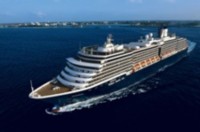 Neither Gail nor I had previously been on a cruise, and neither of us had been to Alaska. Sounds like a good reason to take off on an Alaskan Cruise. In addition to having an opportunity to be pampered aboard a ship for a week, we would be able to experience the scenery and culture of the Alaska Panhandle.
Neither Gail nor I had previously been on a cruise, and neither of us had been to Alaska. Sounds like a good reason to take off on an Alaskan Cruise. In addition to having an opportunity to be pampered aboard a ship for a week, we would be able to experience the scenery and culture of the Alaska Panhandle.
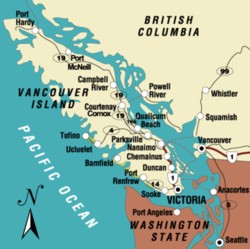 We chose the Holland America Line’s Zuiderdam out of Vancouver. But that was only a part of our vacation. Prior to boarding the ship, we spent a glorious week in Victoria (August 22 – 29), visiting our friends Paul and Sherry. And a wonderful time we had, being superbly escorted by Paul & Sherry and another friend, Lorna, through Buchart Gardens, Cathedral Grove, the outdoor murals of Chemainus, the Cherry Point Vineyards on Cowichan Bay, Sidney’s Shaw Ocean Discovery Centre, the totem poles of Duncan, Emily Carr House and her paintings in the Victoria Art Gallery and, of course, a delicious helping of Bangers and Mash at a downtown British-style pub – a complete vacation in itself.
We chose the Holland America Line’s Zuiderdam out of Vancouver. But that was only a part of our vacation. Prior to boarding the ship, we spent a glorious week in Victoria (August 22 – 29), visiting our friends Paul and Sherry. And a wonderful time we had, being superbly escorted by Paul & Sherry and another friend, Lorna, through Buchart Gardens, Cathedral Grove, the outdoor murals of Chemainus, the Cherry Point Vineyards on Cowichan Bay, Sidney’s Shaw Ocean Discovery Centre, the totem poles of Duncan, Emily Carr House and her paintings in the Victoria Art Gallery and, of course, a delicious helping of Bangers and Mash at a downtown British-style pub – a complete vacation in itself.
We said our Good-Byes to Paul & Sherry and boarded the Zuiderdam just past noon on Saturday, August 29th (my birthday, for your future reference). I’ll not dwell on the ship or the cruise, itself, other than to say it was classy and enjoyable. I’m here to talk about Alaska.
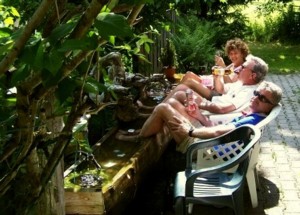 Keep in mind, though, that my kind of vacation is tramping around the Swiss Alps above Kandersteg by day with my buddies; retiring to Chalet Onyx in the evening to soak our tired feet in the cool trickling Alpine waters of the trough while uncapping a Quöllfrisch and contributing lies about how tough conditions were on the trail that day. There'd be no chance of hearing the crystal clear chiming of brass Swiss cow bells or the opportunity to pat a goat aboard a cruise ship, and I couldn't imagine there being even one slice of bergkäse (mountain cheese) to savour. It just wouldn’t be the same.
Keep in mind, though, that my kind of vacation is tramping around the Swiss Alps above Kandersteg by day with my buddies; retiring to Chalet Onyx in the evening to soak our tired feet in the cool trickling Alpine waters of the trough while uncapping a Quöllfrisch and contributing lies about how tough conditions were on the trail that day. There'd be no chance of hearing the crystal clear chiming of brass Swiss cow bells or the opportunity to pat a goat aboard a cruise ship, and I couldn't imagine there being even one slice of bergkäse (mountain cheese) to savour. It just wouldn’t be the same.
But, I digress. You have to try new things and the cruise turned out to be delightful in it’s own way.
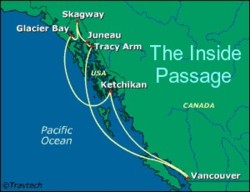 We headed northward, out of Vancouver, at 5:00pm, toward Alaska via the Inside Passage. Our destination, the Alaska Panhandle, clings to the side of northern British Columbia. About 800 nautical miles, and 39 hours, later we were there. Lots to do aboard the ship during the cruise upward, in terms of on-board entertainment, and superb coastal BC mountain scenery all along the way.
We headed northward, out of Vancouver, at 5:00pm, toward Alaska via the Inside Passage. Our destination, the Alaska Panhandle, clings to the side of northern British Columbia. About 800 nautical miles, and 39 hours, later we were there. Lots to do aboard the ship during the cruise upward, in terms of on-board entertainment, and superb coastal BC mountain scenery all along the way.
Tracy Arm
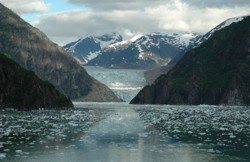 Covering 653,179 acres, Tracy Arm in the Tongass Forest, gave us our first exposure to “Alaska”. This spectacular glacier-carved fjord has sheer vertical walls that clearly showcase nature's artistry. It was remarkable how the crew negotiated that rather large ship (935 ft long; 106 ft wide) through the narrow passages. The fjord twists and turns for over 30 miles, culminating in a spectacular view of the twin tidewater (sea level) Sawyer Glaciers, among others.
Covering 653,179 acres, Tracy Arm in the Tongass Forest, gave us our first exposure to “Alaska”. This spectacular glacier-carved fjord has sheer vertical walls that clearly showcase nature's artistry. It was remarkable how the crew negotiated that rather large ship (935 ft long; 106 ft wide) through the narrow passages. The fjord twists and turns for over 30 miles, culminating in a spectacular view of the twin tidewater (sea level) Sawyer Glaciers, among others.
Literally hundreds of waterfalls cascade down the sides of the fjord. Famed naturalist John Muir compared the glacial-carved sheer granite cliffs in the area to those of Yosemite, saying that this region was even more spectacular than the more well-known Yosemite valley.
Juneau
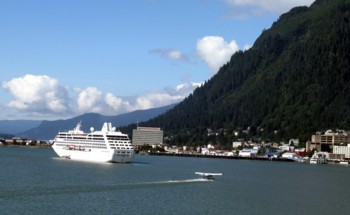 And then we were off to Juneau, the Capital of Alaska. At 3,255 square miles in area, Juneau is the largest American Capital (in area). It is also the only Capital that is not accessible by roadway. As they say in Juneau, "There’s only 3 ways to get here: fly in, float in or be born here".
And then we were off to Juneau, the Capital of Alaska. At 3,255 square miles in area, Juneau is the largest American Capital (in area). It is also the only Capital that is not accessible by roadway. As they say in Juneau, "There’s only 3 ways to get here: fly in, float in or be born here".
Juneau’s population is normally 31,000, but it grows to 38,000 or so on the days when up to 4 cruise ships arrive in port (which can be any day during the summer months). The locals know exactly what to do about having a supply of 7,000 new credit cards within their grasp for a few hours. As I understand it, Juneau is a Haida word for “city of cheap jewellery stores and tacky souvenir shops”. Unfortunately, cruise ship tourism seems to be coming out on top as the main industry in this area of Alaska.
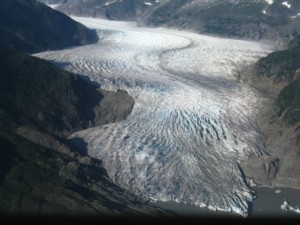 Best to head out of town if you want to see the real “Alaska”. We opted for a floatplane tour over the nearby glaciers, and we certainly made the right choice.
Best to head out of town if you want to see the real “Alaska”. We opted for a floatplane tour over the nearby glaciers, and we certainly made the right choice.
Juneau is surrounded by 3,500 – 4,000 foot high mountains. Atop these mountains is the Juneau Icefield. At 1,500 square miles the Icefield is home to over 40 large valley glaciers, including the Mendenhall Glacier (eyes left), and 100 smaller ones. We had a wonderful bird’s eye view of the fabulous scenery. Truly an experience to remember.
Skagway
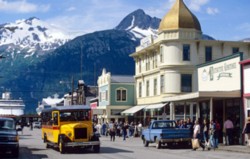 Skagway had been a city until 2007 when it was reclassified to borough status. I think it’s population of 862 made the reclassification a no brainer. As our onboard comedian described its size, “Skagway is the only town I’ve seen where the ‘Now Entering’ and the ‘Now Leaving’ signs are nailed to the same post.” Our ship docked, basically, in the middle of Main Street.
Skagway had been a city until 2007 when it was reclassified to borough status. I think it’s population of 862 made the reclassification a no brainer. As our onboard comedian described its size, “Skagway is the only town I’ve seen where the ‘Now Entering’ and the ‘Now Leaving’ signs are nailed to the same post.” Our ship docked, basically, in the middle of Main Street.
Skagway is another popular cruise ship destination. It is estimated that they have access to approximately 900,000 new credit card toting cruise ship visitors each year. As I understand it, Skagway is a Taku word for “borough of cheap jewellery stores and tacky souvenir shops”.
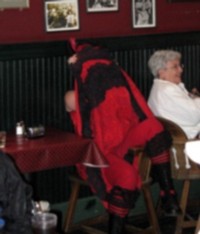 However, Skagway deserves high marks for masking the un-pleasantries with storefronts and wooden sidewalks that take one far back in time to an era when you could expect the infamous local conman, Soapy Smith, to jump out at any moment from an alleyway in pursuit of the greenbacks in your wallet. (Soapy didn’t get to know about credit cards as he was killed during a gun battle on a Skagway wharf in 1898 – a dispute over money of course.)
However, Skagway deserves high marks for masking the un-pleasantries with storefronts and wooden sidewalks that take one far back in time to an era when you could expect the infamous local conman, Soapy Smith, to jump out at any moment from an alleyway in pursuit of the greenbacks in your wallet. (Soapy didn’t get to know about credit cards as he was killed during a gun battle on a Skagway wharf in 1898 – a dispute over money of course.)
We spent a few delightful hours drinking in the charm this place has to offer, including drinking down a pint each at the Red Onion Saloon (and Bordello). Then we were off on a rail excursion to the White Pass.
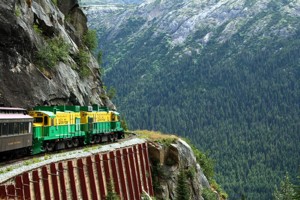 Skagway was the gateway to the Klondike Gold Rush. Construction began on the narrow gauge White Pass Railway in 1898 to transport the hordes of prospectors up to the Klondike River, near Dawson City in the Yukon, thus allowing them to avoid the treacherous Chilcoot Pass which could be navigated only on foot. The railway climbs 3,000 feet to the White Pass in 20 miles with grades up to 3.9%, cliff-hanging turns of 16 degrees, two tunnels and numerous bridges and trestles.
Skagway was the gateway to the Klondike Gold Rush. Construction began on the narrow gauge White Pass Railway in 1898 to transport the hordes of prospectors up to the Klondike River, near Dawson City in the Yukon, thus allowing them to avoid the treacherous Chilcoot Pass which could be navigated only on foot. The railway climbs 3,000 feet to the White Pass in 20 miles with grades up to 3.9%, cliff-hanging turns of 16 degrees, two tunnels and numerous bridges and trestles.
Taking just over a year to complete, which is an amazing feat given the terrain and working conditions, the White Pass Railway remains an International Historic Civil Engineering Landmark, a designation shared with the Panama Canal, the Eiffel Tower and the Statue of Liberty. Unfortunately the Gold Rush was all but over by the time the railway was completed.
Our ride to the White Pass summit and back to Skagway was yet another thrilling Alaskan experience. As a note of interest, Skagway is part of the setting for Jack London’s book The Call of the Wild.
Glacier Bay National Park and Preserve
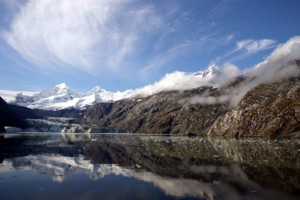 Comprised of 3.3 million acres of mountains, glaciers, forests, and waterways, Glacier Bay National Park and Preserve are a highlight of the Inside Passage and part of a 25-million-acre World Heritage Site – one of the world’s largest protected natural areas – designated by UNESCO. (I stole that, and other lines, from the brochure)
Comprised of 3.3 million acres of mountains, glaciers, forests, and waterways, Glacier Bay National Park and Preserve are a highlight of the Inside Passage and part of a 25-million-acre World Heritage Site – one of the world’s largest protected natural areas – designated by UNESCO. (I stole that, and other lines, from the brochure)
Glaciers descending from high snow capped mountains into the bay create spectacular displays of ice and iceberg formation. I can’t tell you exactly how many glaciers we saw during our visit to Glacier Bay – dozens is my best guess, some of them high above us on the mountain tops and others up close and personal like tidewater glaciers Margerie and Lamplugh.
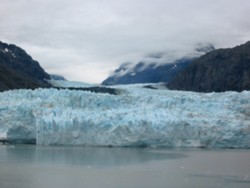 As a special treat, the Margerie Glacier displayed her magnificence for us by calving twice as we watched from an almost too close proximity, “calving” being the term used to describe what happens when a portion of the front face of a glacier breaks away and falls into the sea.
As a special treat, the Margerie Glacier displayed her magnificence for us by calving twice as we watched from an almost too close proximity, “calving” being the term used to describe what happens when a portion of the front face of a glacier breaks away and falls into the sea.
I am amazed at how the crew navagated the Zuiderdam up through 65 miles of that narrow fjord and then found a way to turn the ship around and head back out in a space that rendered a U-turn impossible.
Oh, and did I mention the numerous humpback whales that were surfacing at various points along the way?
Ketchikan
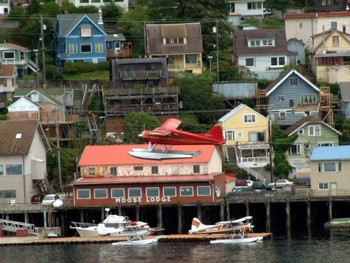 Ketchikan self-claims the title of “Salmon Capital of the World”, but also holds the title of “Rainiest City in North America”, averaging 160 inches of rain each year, with some years topping the 200 inch mark. However, as with all other days on our Alaskan visit, Ketchikan blessed us with fine, if a bit overcast, weather. But no rain. Although this area of the Alaska Panhandle is in the vicinity of the 58th parallel, its weather wasn’t a lot colder than what’s delivered to Nova Scotia each September, at the 45th parallel.
Ketchikan self-claims the title of “Salmon Capital of the World”, but also holds the title of “Rainiest City in North America”, averaging 160 inches of rain each year, with some years topping the 200 inch mark. However, as with all other days on our Alaskan visit, Ketchikan blessed us with fine, if a bit overcast, weather. But no rain. Although this area of the Alaska Panhandle is in the vicinity of the 58th parallel, its weather wasn’t a lot colder than what’s delivered to Nova Scotia each September, at the 45th parallel.
This place has city status and boasts a population of about 7,500 people, almost equal to the number of cruise ship tourists who arrive on a normal day during cruise ship season. As I understand it, Ketchikan is a Tlingit word for “yet another city of cheap jewellery stores and tacky souvenir shops”. (You getting my drift yet?)
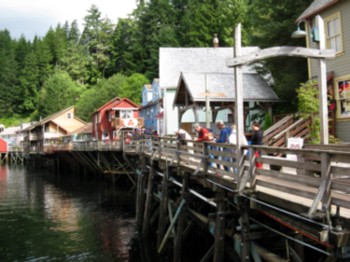 But, to be fair, Creek Street is a worthwhile stopover before heading away from the gift shops and tourists. Creek Street is a row of wooden buildings perched over the water on pilings. The brightly painted shops once catered to gentlemen seeking something other than tacky souvenirs. The museum at Dolly's House gives you a glimpse into the way things used to be, though Ketchikan's red-light district wasn't closed down until 1953.
But, to be fair, Creek Street is a worthwhile stopover before heading away from the gift shops and tourists. Creek Street is a row of wooden buildings perched over the water on pilings. The brightly painted shops once catered to gentlemen seeking something other than tacky souvenirs. The museum at Dolly's House gives you a glimpse into the way things used to be, though Ketchikan's red-light district wasn't closed down until 1953.
In the waters that runs through Creek Street we saw hundreds, perhaps thousands, of salmon heading upstream, leaping into the air while navigating the rapids. The locals will tell you that this is the area where both salmon and members of the human male population came to spawn.
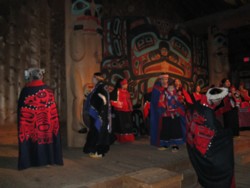 Legends of a different sort are recorded on totem poles. This area boasts the world's largest collection of Northwest totems. We headed to Saxman to the Tlingit (pronounced “klin’-kit”) Native Village to see a significant number of the totem poles. There we were invited into the clan house to experience a demonstration of traditional dance and song by the Cape Fox Dancers. Also, we had the pleasure of watching carvers at work, including Nathan Jackson, perhaps Alaska's greatest contemporary artist, who has been honored by a postage stamp.
Legends of a different sort are recorded on totem poles. This area boasts the world's largest collection of Northwest totems. We headed to Saxman to the Tlingit (pronounced “klin’-kit”) Native Village to see a significant number of the totem poles. There we were invited into the clan house to experience a demonstration of traditional dance and song by the Cape Fox Dancers. Also, we had the pleasure of watching carvers at work, including Nathan Jackson, perhaps Alaska's greatest contemporary artist, who has been honored by a postage stamp.
At each stopover, one has the choice of any number of shore excursions. In Ketchikan, we chose Saxman but there is also a helicopter, and a float plane, tour of Misty Fjords National Monument that deserves mention. “Its 2.3 million acres include soaring cliffs, sawtooth ridges shrouded in mists, sky-blue lakes, hanging valleys, countless waterfalls, bottomless saltwater fjords, and miles of glaciers. And the monument is home to a multitude of wildlife”, reads the brochure. I understand this to be an excellent experience, quite in line with our float plane tour over the glaciers at Juneau.
Homeward Bound
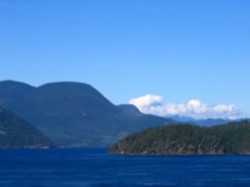 Back onboard we were now on the final leg of our journey, heading to Vancouver. This would be a 36-hour trip but far less than boring with lots of activities on the ship and a second exposure to the gorgeous scenery along the BC coast. Unfortunately, something called seasickness finally nailed me. They say that when seasickness first hits, you are afraid that you are going to die. Then as it progresses, you are afraid you are NOT going to die. However, in my case, Mr. Gravol waved his magic wand successfully.
Back onboard we were now on the final leg of our journey, heading to Vancouver. This would be a 36-hour trip but far less than boring with lots of activities on the ship and a second exposure to the gorgeous scenery along the BC coast. Unfortunately, something called seasickness finally nailed me. They say that when seasickness first hits, you are afraid that you are going to die. Then as it progresses, you are afraid you are NOT going to die. However, in my case, Mr. Gravol waved his magic wand successfully.
Arriving back at Canada Place and disembarking before noon on Saturday, September 5th, Vancouver was all ours to explore for the next 3 days prior to heading home. We were pleasantly surprised to discover the warm friendliness of the Vancouver people - everyone from hotel and restaurant staff, to bus and taxi drivers as well as all venue attendants. We now have fond memories of the Emily Carr exhibit in the Vancouver Art Gallery, our stroll through Granville Island, our tour through the charming Dr. Sun Yat–Sen Classical Chinese Garden and, of course, our visit to Stanley Park and it’s Vancouver Aquarium, topped off with a delicious meal at The Fish House.
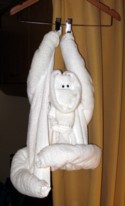 All in all, a wonderful vacation. I am not a cruise ship kind of guy but I’ll have to admit that they do it up in style. They keep you comfortable, well fed and entertained for the entire week. Even though there are up to 2,000 passengers on the Zuiderdam, the crew of 794 (better than a 1 to 3 ratio) take good care of each and everyone. Onboard entertainment consisted of a 6-piece band with a 2 male, 2 female singing quartet; a 3-piece jazz band; a classical string quartet; a lady singer/piano player; a comedian; a magician; 2 swimming pools; a health spa; game shows and various lectures and demonstrations including such things as Alaskan geography and history; the inner workings of the ship; fitness; cooking; flower arranging; wine & cheese sampling and even a session on how to fold your bath towel to make it look like an cute little fluffy animal (and it’s none of your business which of the demonstrations I attended).
All in all, a wonderful vacation. I am not a cruise ship kind of guy but I’ll have to admit that they do it up in style. They keep you comfortable, well fed and entertained for the entire week. Even though there are up to 2,000 passengers on the Zuiderdam, the crew of 794 (better than a 1 to 3 ratio) take good care of each and everyone. Onboard entertainment consisted of a 6-piece band with a 2 male, 2 female singing quartet; a 3-piece jazz band; a classical string quartet; a lady singer/piano player; a comedian; a magician; 2 swimming pools; a health spa; game shows and various lectures and demonstrations including such things as Alaskan geography and history; the inner workings of the ship; fitness; cooking; flower arranging; wine & cheese sampling and even a session on how to fold your bath towel to make it look like an cute little fluffy animal (and it’s none of your business which of the demonstrations I attended).
Even so, given all of that attention paid to keeping the passengers entertained, you’d think they would have been able to find room to include at least one alphorn player or a handful of Swiss yodelers.
Jerome Bruhm aka Alpenkrieger

If you made it this far without falling asleep, and you want to see more, click on the Picasa Photo Album tab at the top of this article for a cruise to Alaska and back through a camera lens. But be forewarned before you go there, I have included a LOT of photos in the album. The slide show is about 12 1/2 minutes long. Enter only at your own desire.
Disclaimer: While the vast majority of the photos are mine, about a half-dozen were taken by others.
|